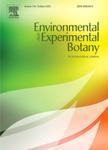版权所有:内蒙古大学图书馆 技术提供:维普资讯• 智图
内蒙古自治区呼和浩特市赛罕区大学西街235号 邮编: 010021

作者机构:Univ Sao Paulo Inst Biociencias Dept Bot Rua Matao 277 BR-05508090 Sao Paulo Brazil Univ Fed Goias Inst Ciencias Biol Dept Bot Ave Esperanca S-NCampus Samambaia BR-74690900 Goiania Go Brazil
出 版 物:《ENVIRONMENTAL AND EXPERIMENTAL BOTANY》 (环境与实验植物学)
年 卷 期:2020年第173卷
页 面:104003-000页
核心收录:
学科分类:0710[理学-生物学] 071001[理学-植物学] 0830[工学-环境科学与工程(可授工学、理学、农学学位)] 07[理学]
基 金:Universidad Nacional de Rosario
主 题:PEPCK Guzmania monostachia Decarboxylation Photosynthesis Drought Malic acid
摘 要:Crassulacean acid metabolism (CAM) is a photosynthetic pathway characterized by nocturnal CO2 fixation into organic acids followed by their diurnal decarboxylation. Decarboxylation activity is time regulated, usually presenting higher activity in the middle of the day. This process can be performed by phosphoenolpyruvate carboxykinase (PEPCK) and/or by malic enzyme, resulting in an increase in internal CO2 concentration which may act to suppress photorespiration. It is suggested that the CO2 provided by the decarboxylation can improve the photochemical use of energy in CAM plants. This photosynthetic pathway also contributes to improve water use efficiency, and, in an interesting way, some species can engage this photosynthesis when subjected to water deficit. Guzmania monostachia is a bromeliad that occupies habitats with intermittent water availability and CAM can be induced by water deficit. To test the light-time modulation of decarboxylation activity and light-energy use in G. monostachia, we analyzed the activity of PEPCK, the main decarboxylating enzyme for this bromeliad, as well as the photochemical and non-photochemical quenching and organic acids contents at three times of the day. Results showed a diurnal modulation where the highest PEPCK decarboxylation activity coincided with an increase in the photochemical quenching and a decrease in the non-photochemical quenching. In addition, a reduction in acid content was observed, strongly indicating the interface between CO2 generation through acid decarboxylation and its effect on PSII photochemical activity and photorespiration in CAM-induced plants. The same was not observed for well-watered plants. Also, PEPCK activity modulation may be related to transcriptional and post-translational regulation, since an increase in transcript abundance and a modulation in the dephosphorylated enzyme activity was noted. Moreover, we suggest that the time modulation of PEPCK plays an important role in regulating PSII ene